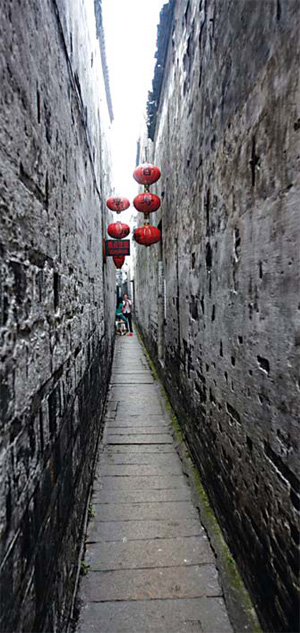 |
|
Shipi lane, paved with 216 slab stones, is mere 1-m wide. |
 |
|
Shipi lane, paved with 216 slab stones, is mere 1-m wide. |
Compared to Zhouzhuang and Wuzhen, Zhejiang province's Xitang is far less well known. But even so, it formed the backdrop to director John Woo's epic blockbuster Mission Impossible III.
I first learnt about the town from a travel blog. Ever since I've been itching to get a closer look at its extraordinary beauty.
After an approximately one-hour drive from Shanghai, I arrive at Xitang train station. I am surprised to see the area dominated by hotels, residential buildings as well as large squares, just like those in the city I'm trying to escape.
"This is not the place you are planning to visit. That lies beyond the end of the road," says a pedicab driver at the station. After some bargaining, he takes me through long, narrow lanes, until I find myself in the small and mystical water town with a 1,000-year history.
This has to be a photographer's dream destination. Every turn throws up an amazing vista that makes for quite an extraordinary photograph, by even the most clumsy shutterbug.
Stone-paved trails lead to old houses with carved wooden windows, tiled roofs, and lines of red lanterns, that line the water's edge. The whole town seems untouched by modern life. Residents, unfazed by the sight of tourists like me, go about their everyday business, starting up fires for their cooking and doing their laundry by the river running through the town.
And where there is water, there has to be bridges. More than 100 stone arch and beam bridges of different shapes and sizes connect the water town into one entity. Among these thousand-year-old bridges, a prominent one is Songzi Laifeng Qiao. The story goes that crossing it will bring one many sons and daughters.
The town is crisscrossed by lanes - 122 in all - which have their own hierarchy of importance. The most famous is Shipi lane, paved with just 216 slab stones, and a mere 1-m-wide. At its narrowest, it is barely 0.8 m, so that I can hardly even extend my arms all the way. But it is a good place to strike a pose, holding yourself between the walls, just like Spiderman.
During the Ming (1368-1644) and Qing (1644-1911) dynasties, Xitang was a commercial town with many shops lining the banks of the river. The roofed corridors of storefronts, extending up to 1,000 m, bear witness to this past. Once a place for trading, they now house shops, hostels, tea houses and restaurants.
After strolling for several hours, I stop by for a late lunch at a restaurant by the water, with a perfect view of the town.
It soon starts raining. The entire landscape is veiled in a thin mist with the rainwater falling and disappearing into the river.
The romance of the scene washes over me and I call to the waiter: "Please get me a bottle of the local yellow wine."
However, I fail to finish it, thanks to its strong flavor.
It is time to get back to reality.